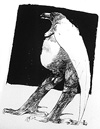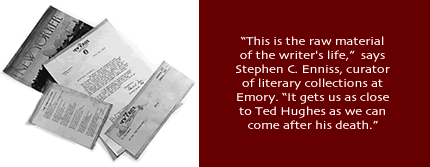 LONG
SHROUDED in
a cloud of speculation and revulsion, the
prolific and publicly aloof British Poet Laureate Ted Hughes
has revealed himself to the world at last. This April, two years
after Hughes’ death from cancer, Emory University opened
the Hughes archive, a treasure trove of manuscript drafts, correspondence,
scrapbooks, documents, photographs, and sound recordings. LONG
SHROUDED in
a cloud of speculation and revulsion, the
prolific and publicly aloof British Poet Laureate Ted Hughes
has revealed himself to the world at last. This April, two years
after Hughes’ death from cancer, Emory University opened
the Hughes archive, a treasure trove of manuscript drafts, correspondence,
scrapbooks, documents, photographs, and sound recordings.
Hughes
agreed to sell the collection to Emory shortly before his death.
Dating from 1940 to 1997, the two-and-a-half-ton collection
arrived at Emory in 1997 packed in eighty-six seed and champagne
boxes that had been stored in a barn next to Hughes’ thatched
cottage in North Tawton, Devon. Staff in Emory’s Special
Collections Department spent two years sorting and cataloguing
the papers. The archive also contains a sealed footlocker to
be opened in twenty-five years.
The
collection has drawn scholars from around the world hoping to
probe the creative intellect of a poet whose self-imposed public
silence after the 1963 suicide of his wife, the American poet
and novelist Sylvia Plath, kept him at arm’s length.
“That’s
the value of the archive,” says Stephen C. Enniss, curator
of literary collections at Emory who mounted an exhibition in
April to commemorate the opening. “This is the raw material
of the writer’s life. It gets us as close to Ted Hughes
as we can come after his death.”
Born
in 1930 in West Yorkshire, Hughes was a student at Pembroke
College, Cambridge, where he studied English, anthropology,
and archaeology and published his earliest poems. Hughes’
first collection, A Hawk in the Rain, was selected as the best
first collection in a poetry contest judged by British poets
W. H. Auden, Marianne Moore, and Stephen Spender. The success
of Hawk launched Hughes’ literary career. During his lifetime,
he published numerous poetry collections—including Lupercal,
Crow, Mooretown, River, and Birthday Letters—as well as
translations, children’s books, and Shakespearean criticism.
The
piles of manuscripts in the archive reveal the craft of a great
artist who methodically revised his manuscripts. His correspondence
contains powerful prose.
“I
would love to be around in fifty years’ time when Hughes’
collected letters are published,” Diane W. Middlebrooke,
a professor of English at Stanford University who is at work
on a book about Hughes’ later life, told the Times of London.
“I think he’ll be remembered as one of the great letter
writers of the twentieth century. It’s clear he did a lot
of thinking in his letters.”

A
large portion of the letters are written to Lucas Myers, a fellow
writer and Hughes’ friend since their university days.
Hughes’ letters to Myers include reflections on his own
work, discussions of his ambitions and directions as a writer,
and his views of other poets. (He describes Robert Frost as
a “very queer old monologuing character, but very good,”
and he criticizes e.e. cummings relentlessly.)
Not
surprisingly, the archive’s opening resulted in a flurry
of media attention to the documents relating to Hughes’
relationship with Plath. Given the couple’s habit of conserving
paper by writing on the opposite sides of one another’s
works, their literary relationship is almost impossible to ignore.
One document that has received extensive media attention is
a brittle piece of paper, torn and taped back together, containing
a draft of Hughes’ unpublished poem “Digging”:
“The robin stamps on its twig/The robin’s throat shakes
out a banner,” it begins. Flip the paper over, and there
is a page of text, slashed crosswise with a blue pencil, with
the typewritten heading “The Bell Jar,” and the page
number “Plath 254.” The text was not part of Plath’s
final published novel.
Enniss
describes the manuscript as a “wonderful metaphor”
for the poets’ intertwined enterprise.
“What
I find most intriguing is what this artifact says about the
intimacy of their collaborative relationship,” he says.
“There’s a degree of debate over whether their relationship
was constructive, and who was the dominant talent and who fed
whose work. When I see such things, it evokes for me a very
collaborative literary life.”—Sharla A. Paul
|